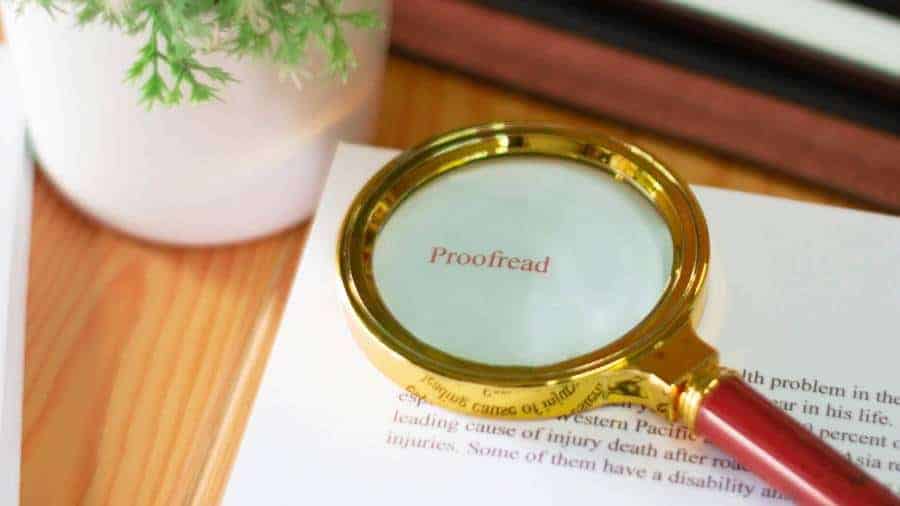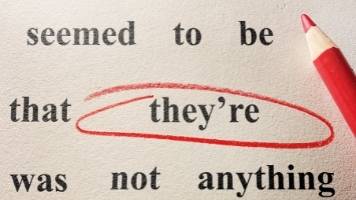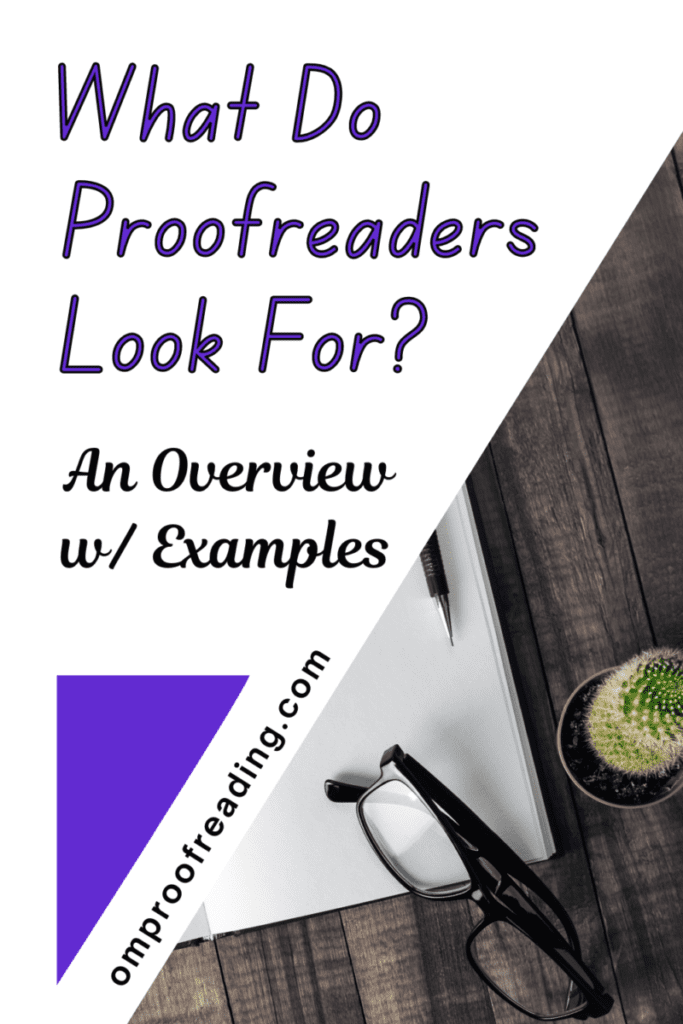This article may contain affiliate links. Please see our affiliate disclaimer in the footer menu for more information. Thank you for your support!

As a professional proofreader, I can tell you precisely what proofreaders look for each time they work on a document. A proofreader has a specific role that involves identifying and correcting several kinds of mistakes.
Proofreaders look for errors in five main categories: grammar, capitalization, punctuation, spelling, and formatting. They also ensure proper word choices and check for repeated or omitted words. Finally, proofreaders make sure writing adheres to the guidelines in the appropriate style guide.
Let’s examine the principal areas proofreaders pay attention to when working on a text. We’ll also look at some examples within each of these areas.
Note: Proofreaders who work for publishing companies have a somewhat different scope of work since they deal with typeset documents.
What Do Proofreaders Look For?
Proofreaders use their skills and sharp eyes to eradicate as many errors as possible from every document they work on.
But what are they searching for with those discerning eagle eyes?
Proofreaders Look for Grammar Goofs
Proofreaders are responsible for guarding against grammar goofs. Grammar deals with how we put words together to form sentences. We can classify words according to their part of speech. However, we need to remember that a single word can function as more than one part of speech.
You’re probably familiar with the eight parts of speech: nouns, pronouns, verbs, adjectives, adverbs, prepositions, conjunctions, and interjections.
Proofreaders correct a myriad of mistakes related to the parts of speech. Let’s examine each one to see where we often encounter problems. We’ll also see some specific examples.
1) Common Problems with Nouns
Subject/verb agreement, making nouns plural, making nouns possessive
Problem: Making Nouns Plural
Incorrect: He keeps his knifes sharp to make cutting food easier.
The plural of knife is knives. It’s an irregular plural, meaning it doesn’t follow the usual rules for making a noun plural. Proofreaders who work on texts written by ESL speakers are more likely to encounter this type of mistake.
Correct: He keeps his knives sharp to make cutting food easier.
2) Common Problems with Pronouns
Pronoun/antecedent agreement, use of the three pronoun cases (nominative, possessive, and objective)
Problem: Deciding Which Pronoun Case to Use

Incorrect: Ann bought concert tickets for my sister and I.
The pronoun I is in the nominative case. The pronoun must be in the objective case for this to be a correct sentence. (You wouldn’t say, “Ann bought concert tickets for I.”)
Correct: Ann bought concert tickets for my sister and me.
3) Common Problems with Verbs
Forming irregular verbs, using verbals (infinitives, gerunds, and participles), verb pairs (e.g., sit vs. set), shifting verb tenses
Problem: A Verb Pair (Lay vs. Lie)
Incorrect: I’m going to lay on the sofa and watch TV.
Lay means to put or place, and it takes an object.
Lie means to rest or recline, and it does not take an object.
Correct: I’m going to lie on the sofa and watch TV.
4) Common Problems with Adjectives
Forming comparisons, using an adjective where you need an adverb
Problem: Using an Adjective Where You Need an Adverb
Incorrect: They played bad during their last soccer game.
Since the word played is an action verb, we need to use an adverb here instead of an adjective.
We use adverbs with action verbs and adjectives with linking verbs.
Correct: They played badly during their last soccer game.
In my post “Can Adjectives Modify Other Adjectives,” I give more examples of using adjectives with linking verbs.
5) Common Problems with Adverbs
Forming comparisons, adverbs that have two different forms (with ly and without ly), using an adverb where you need an adjective
Problem: Using an Adverb Where You Need an Adjective

Incorrect: She feels badly about letting him down.
Since the word feel is a linking verb in this sentence, we need to use an adjective instead of an adverb.
Correct: She feels bad about letting him down.
Om Proofreading has a post about how to find adverbs if you’d like to learn more about them. This article will teach you about the six main kinds of adverbs, the parts of speech they modify, and much more. It includes a quiz at the end to check your understanding.
6) Common Problems with Prepositions
Deciding which preposition to use with a particular word
Problem: Deciding Which Preposition to Use
Incorrect: I dove in the pool.
The preposition in refers to location. The preposition into indicates motion toward something.
I did not dive while I was in the pool. I stood outside the pool and then dove into it.
Correct: I dove into the pool.
7) Common Problems with Conjunctions
Making a verb singular or plural depending on which conjunction is used, pairing correlative conjunctions (e.g., either with or)
Problem: Pairing Correlative Conjunctions
Incorrect: Neither he or his brother wanted to leave the party.
In the sentence above, we’ve used a pair of correlative conjunctions that don’t belong together (neither and or). We use either with or and neither with nor.
Correct: Neither he nor his brother wanted to leave the party.
8) Common Problems with Interjections
Mistakes with interjections typically involve punctuation, not grammar. For example, if someone shouts an obscenity, you’d want to punctuate that with an exclamation mark instead of a period. 😉
Proofreaders Catch Capitalization Calamities
Proofreaders look for mistakes involving the improper capitalization of nouns.
Of course, we should always capitalize the pronoun I.
And we should capitalize proper nouns but not common nouns (unless they start a sentence).
Proper nouns refer to specific people, places, and things. But common nouns name any person, place, thing, or idea.
A common error with capitalization occurs when writers stumble into what Rebecca Elliott calls the “cap trap” in her book Painless Grammar. The cap trap involves capitalizing words we think are important even though they shouldn’t be capitalized.
Let’s see two examples of capitalization errors.
Capitalization Catastrophe Example #1
Incorrect: He loves history and is especially interested in the stone age.
We capitalize names of prehistoric cultural periods.
Correct: He loves history and is especially interested in the Stone Age.
Capitalization Catastrophe Example #2
Incorrect: Her best buddy is a buddhist.
We capitalize the names of followers of major religions.
Correct: Her best buddy is a Buddhist.
Proofreaders Point Out Punctuation Problems

The most frequently seen punctuation errors come from misusing periods, question marks, exclamation points, commas, semicolons, colons, hyphens, dashes, parentheses, apostrophes, and quotation marks.
Proofreaders also watch for mistakes involving the treatment of numbers and abbreviations, which vary according to the style guide being used. We’ll talk about style guides a bit later.
Let’s look at a couple of examples of problematic punctuation involving two of the most commonly misused punctuation marks: commas and hyphens.
Misuse of a Comma
Incorrect: She loves being a health coach, it’s such a rewarding career!
Here we have two independent clauses separated by a comma, which is a comma splice. Yikes!
When I proofread my blog posts, I sometimes catch a comma splice I’ve inadvertently created. Of course I come across numerous types of boo-boos when I’m proofing my posts, but I seem to have an unfortunate knack for crafting comma splices, lol! 😉
Comma splices are okay under certain circumstances, but generally, we should avoid them.
So back to our example. A comma isn’t quite strong enough to separate two independent clauses. We need the power of a semicolon for that job!
Correct: She loves being a health coach; it’s such a rewarding career!
Misuse of a Hyphen
Incorrect: He’s a widely-known cardiologist.
The words widely known form a compound adjective that modifies the word cardiologist (a noun). We don’t hyphenate compound adjectives composed of an adverb ending in ly + a participle, regardless of whether the compound adjective comes before or after the noun it modifies.
Correct: He’s a widely known cardiologist.
Om Proofreading has an article called “15 Effective Ways to Improve Your Punctuation” if you need help in this area.
Proofreaders Search for Spelling Slipups
Why do proofreaders search for spelling missteps if they can run spell-check?
Although spell-check can detect countless spelling errors, it can’t determine when a word is spelled correctly but used in the wrong context.
When a word is used in the wrong context, it’s frequently a homophone. Homophones are words that sound the same but have different meanings (and usually different spellings).
Here are some examples of homophones:

- cord vs. chord
- fourth vs. forth
- ensure vs. insure
- compliment vs. complement
- vein vs. vane
- stationary vs. stationery
Let’s check out an example of a mistake involving a homophone.
A Homophonic Error that Spell-Check Missed
Incorrect: She had a leading roll in the school play.
Although roll is a word, it’s not the right word in this context.
It would be correct to say, figuratively speaking, that this error rolled right past my spell-check.
However, when we’re talking about a part in acting, the word roll misses the mark.
Correct: She had a leading role in the school play.
I published an article about difficult homophones with a quiz at the end if this topic interests you.
Proofreaders Find Formatting Faux Pas
Proofreaders are on alert for formatting flubs like improper spacing between words, sentences, paragraphs, and headers.
They also make sure paragraphs, lists, headings, subheadings, and other relevant elements are properly aligned and consistently formatted.
Finally, they aim to detect any inconsistencies in font size or type.
Proofreaders who work on books will also need to consider other elements, such as the acknowledgments, table of contents, and index.
They’ll also check for inappropriate word breaks, missing or incorrect page numbers, and other formatting mistakes.
Let’s look at an example of a formatting fail.
Incorrect: He loves to gaze at the ocean.
We’ve got an extra space between the words at and the. Let’s get those words closer together!
Correct: He loves to gaze at the ocean.
Proofreaders Watch for Unwise Word Choices

Occasionally, a writer may use a word in the wrong context. The word just doesn’t mean what they think it means. Although this error happens more frequently with ESL speakers, native English speakers aren’t immune to making this kind of mistake.
More frequently, native English speakers confuse words with similar (but not identical) meanings. Let’s see an example.
Incorrect: There are less glasses on the shelf today than yesterday.
We use the word less with uncountable nouns; however, we use the word fewer with countable nouns. Glasses is a countable noun.
Correct: There are fewer glasses on the shelf today than yesterday.
The most common word usage errors occur with homophones, which we’ve discussed.
However, another tricky area that proofreaders need to pay attention to is the use of expressions. An example will help illustrate this point.
Incorrect: Proofreading and copyediting are not one in the same.
To express that proofreading and copyediting aren’t identical, we need to change one of the words in the phrase one in the same.
Correct: Proofreading and copyediting are not one and the same.
Proofreaders Rake Writing for Repeated or Omitted Words
Incorrect: I’m sure you can identify the the problem in this sentence.
Correct: I’m sure you can identify the problem in this sentence.
Incorrect: The mistake in this sentence also straightforward. (Hint: It’s missing the part of speech that rhymes with curb.) Yep! It’s missing a verb. Specifically, it’s missing the word is.
Correct: The mistake in this sentence is also straightforward.
Proofreaders See that Style Guide Specifications Are Satisfied

The four major style guides used for US English are the following:
- The Chicago Manual of Style (CMOS)
- The Associated Press Stylebook
- MLA (Modern Language Association) Handbook
- Publication Manual of the American Psychological Association
Proofreaders use the style guide that’s appropriate for the kind of content they’re proofreading.
For example, if a proofreader is working on a book, they would refer to CMOS. But if they were proofing a press release, they’d use The Associated Press Stylebook.
Let’s look at an example. We’ll assume this sentence comes from a book, so we’d use CMOS as our style guide.
Incorrect: Before heading out the door, she grabbed her towel, sunscreen and sunglasses.
This sentence is incorrect because CMOS calls for using a serial comma (aka Oxford comma). A serial comma separates each term in a series of three or more. Let’s put in that comma after the word sunscreen.
Correct: Before heading out the door, she grabbed her towel, sunscreen, and sunglasses.
Proofreaders Do Their Due Diligence with Dialects
What in the world am I talking about here?
Proofreaders who proof documents written in English need to know the style of English being used: US, UK, Canadian, or Australian.
Let’s see an example of how we treat a particular word depending on whether the text is written in US or UK English. Variations in vocabulary, grammar, punctuation, and spelling are present between these two English styles.
US vs. UK English (Spelling)
Incorrect in US English: What’s your favourite number?
Although favourite is the preferred spelling in UK English, it isn’t the preferred spelling in US English.
Correct in US English: What’s your favorite number?
This concludes our overview of the mistakes proofreaders try to spot.
I hope this article has given you a clear understanding of what proofreaders look for when scrutinizing a document.
I authored an article all about proofreading, including where it fits into the editorial process and why it’s important if you’d like to know more.
Best wishes to you!
“If you think you are too small to make a difference, try sleeping with a mosquito.”
– Dalai Lama XIV

Recent Posts
Punctuation is important because it enables us to communicate our message clearly and effectively. Without punctuation, we wouldn’t understand how units of a sentence relate to one another or how...
Although you're probably somewhat familiar with adverbs, you may be unaware of sentence adverbs. As a trained proofreader who has studied the parts of speech, I can help you understand this unique...
